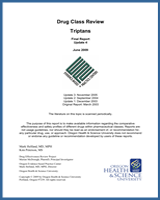NCBI Bookshelf. A service of the National Library of Medicine, National Institutes of Health.
Helfand M, Peterson K. Drug Class Review: Triptans: Final Report Update 4 [Internet]. Portland (OR): Oregon Health & Science University; 2009 Jun.
This publication is provided for historical reference only and the information may be out of date.
The main findings of this review are summarized in Table 8.
Table 8
Summary of the evidence
This review indicates several concrete suggestions for improving the quality of future head-to-head trials. First, studies should compare currently recommended doses. Second, rather than defining a single primary endpoint and selectively reporting others, studies should prespecify a range of endpoints that encompass several aspects of single-headache efficacy at 1 hour, 2 hours, and 24 hours, as well as consistency, satisfaction, function, and quality of life for 6 months or more. Third, more comparisons among triptans other than sumatriptan are needed. Fourth, better evidence concerning the efficacy of triptans for early and mild migraine would improve the applicability of research to everyday practice and could provide a stronger basis for future practice guidelines.
Selection bias in head-to-head trials is a more difficult issue to address. It is increasingly difficult to find triptan-naive patients. We make a few observations: First, there is a role for trials in comparing the efficacy of triptans among patients who are unsatisfied with their current triptan therapy. As long as the studies are clearly described, studies that recruit patients who have been on triptan therapy can be informative. Studies that do recruit such patients need to assess patients’ reasons for wanting to enroll in a trial and their complaints about their current triptan therapy. Second, trials could compare more than 2 triptans and could randomize patients among triptans new to them. The size of the effect of previous triptan use within a particular trial could also be measured. Finally, studies could make greater efforts to draw from the larger denominator of migraineurs who do not seek specialty or even primary medical care and who are less likely to have used triptans.
- Summary - Drug Class Review: TriptansSummary - Drug Class Review: Triptans
Your browsing activity is empty.
Activity recording is turned off.
See more...
